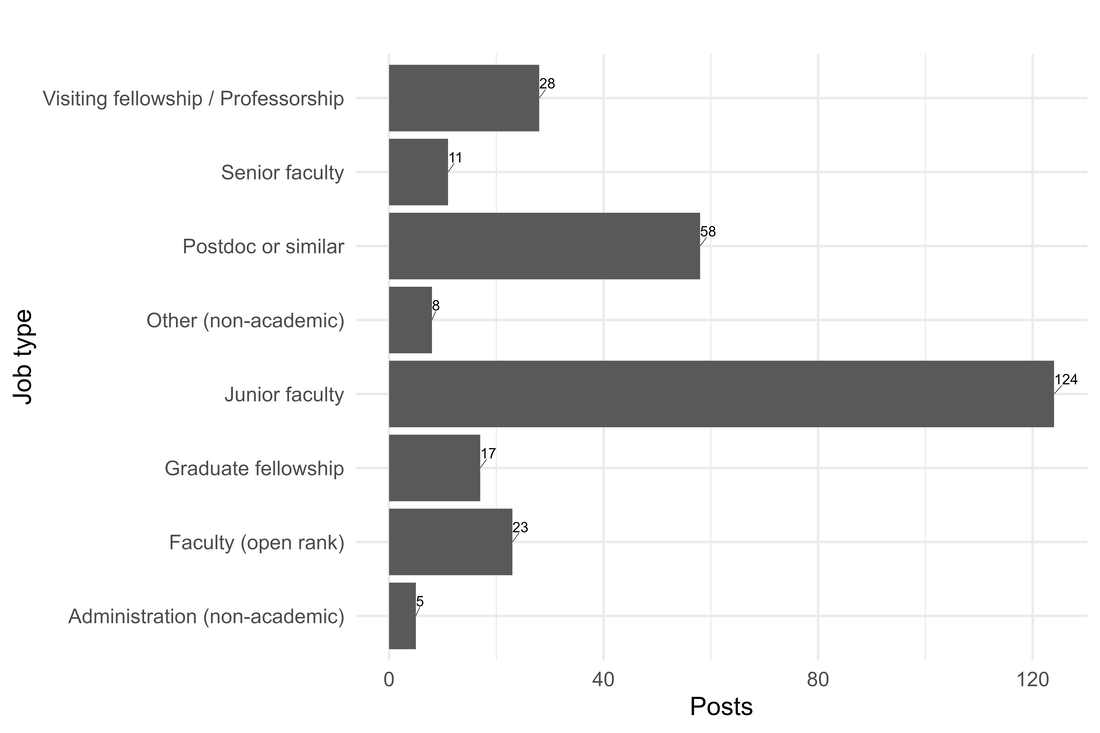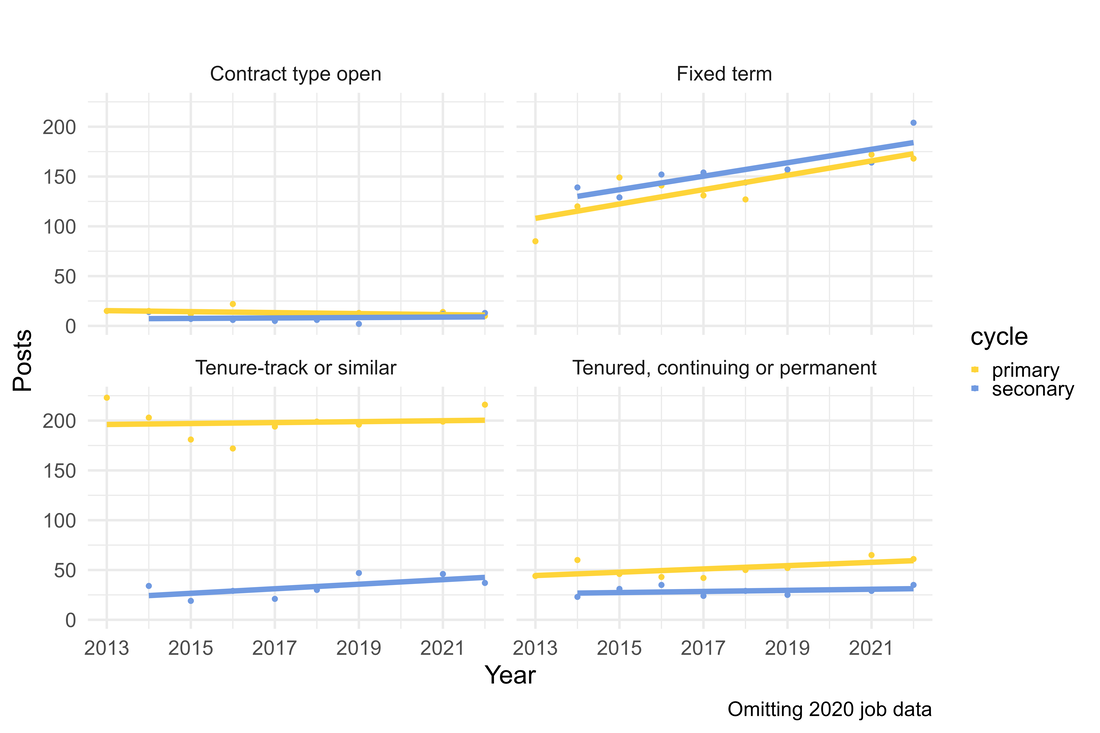Job Market Report, 2023 Secondary Cycle (guest post)
How did the academic philosophy job market look between January and June, 2023?
In the following guest post, Charles Lassiter (Gonzaga) shares data he has gathered on the amount and types of philosophy jobs advertised during the 2023 “secondary cycle” of the job market.
A version of this post first appeared at Professor Lassiter’s site.

[image by Justin Weinberg]
Job Market Report, 2023 Secondary Cycle
by Charles Lassiter
Hi friends! Now that we’re in the dog days of summer, it’s time to look at the job market for the secondary cycle. (Friendly reminder: the primary cycle runs July to December; the secondary cycle runs January to June.) We’ll look at the numbers and focus on a couple of interesting trends.
First up, let’s look at the volume of jobs posted for each of the job types on Philjobs.

As you might expect, junior faculty and postdoc jobs are the most prevalent, followed by visiting and then open rank. But lets put this in historical context.

The colored lines had, at least once, at least 25 postings in a secondary cycle. So this is heartening: ads for both junior jobs and postdocs have been going up over the last decade. Huzzah! All other jobs have either declined slightly or stayed flat. Let’s zoom in on junior jobs.

This is less heartening, but probably expected. Fixed-term jobs are increasing annually at a faster rate than tenure-track jobs. Again, this is for the secondary cycle–I think received wisdom is that fixed-term jobs are more prevalent here than in primary cycle. So let’s check the data for this. (BTW we’re more interested in general trends now, so I’m going to drop annotating the lines with numbers.)

What we have here breaks out jobs by: (1) year, (2) cycle, and (3) contract type. This confirms our earlier suspicions: more TT jobs are posted in the primary than the secondary cycle and slightly more fixed-term jobs are posted in the secondary cycle.
But there’s something odd here: the trend line for TT jobs for the primary cycle is decreasing while the trend for fixed-term jobs for both cycles is increasing. This suggests that there are fewer TT jobs and more fixed-term jobs as time goes by. Let’s check this. First, we’re going to exclude 2020–that was a terrible year for the job market and perhaps that’s dragging the TT primary cycle trend line down.

That’s not much comfort. Excluding the worst year for the market since 2008, TT jobs tend to stay steady while fixed-term jobs increase.
Another possibility is that the trend lines are affected by the number of jobs posted each year. Fewer posts means fewer TT and fixed-term jobs. Maybe scaling TT and fixed-term jobs to number of posts tells a different story?

Ok so the story here looks slightly worse. Relative to all postings in a year, there are progressively fewer TT jobs and more fixed-term jobs for the primary cycle. Fixed-term jobs remain relatively stable for secondary cycles over the last decade while TT jobs are increasing slightly during second cycles. Let’s switch back to raw (instead of relative) counts for a moment and look at fixed-term and TT jobs by cycle.

Indeed the trend seems to be fewer TT jobs and more fixed-term jobs advertised in the primary cycle.
I’m as much of a Pessimistic Paulie as the next philosopher, but maybe, maybe there’s reason for a guarded optimism. Take a look at the trends in the differences between TT and fixed-term jobs advertised by year and cycle.

This suggests that, over the last decade, the differences between the number of TT and fixed-term jobs generally decreases.
What can we conclude from all this? First, we shouldn’t expect the number of fixed-term jobs to overtake the number of TT jobs, at least not in the near future. Second, this is consistent with more fixed-term and fewer TT jobs advertised. (Note that this does not include adjuncts. It’s hard to find reliable data—or any data—for that matter) on adjunct positions.)
The safe bet is this: there will continue to be fewer TT jobs and more fixed-term jobs in the near future, but long term there will continue to be more TT than fixed-term jobs. At least, that’s the hope.
That’s all. If you have any other analyses you’d like to see, please let me know! I’ve posted the data and code for these analyses here.


I would suggest that an appropriate comparator for fixed term positions is not only TT positions but also adjunct/course lecturer/sessional positions — that is positions that involve teaching only one course. Some institutions have, quite rightly, recognized the adjunct positions as exploitative and moved to bundling courses into fixed term positions. That comparison however is harder to gather data for.
thanks for the suggestion. I would love it if I could find data on adjunct or 1-course positions. some are advertised on Philjobs and other sites but nothing systematic. I strongly suspect that’s because adjunct positions are seen as expendable and not worth keeping data on
These data corroborate what has been a trend for many decades: Getting rid of tenured faculty without getting rid of tenure, by hiring fewer and fewer people to tenure-track positions as tenured faculty leave or retire. The financing of higher education and level or declining enrollment have combined to force this change. This is survival-positive behavior and should not be taken personally.
Except in the 40 or so elite private and public institutions, the vast majority of courses have been taught by non-tenure-eligible faculty for decades. As the last several decades of hires to the tenure track who have become tenured now age in place, the number of new tenure-track positions should be expected to continue to decline, especially as enrollment continues to drop. Applicants to graduate programs should look only at placement to tenure-track positions data and think long and carefully about applying to programs with low or non-existent placement to such positions.
Does this data include community college jobs? If not, why? Incidentally, it seems like philjobs doesn’t even list cc jobs (or at least not that I’ve noticed).
The profession as a whole does its best to exclude community college jobs, so it’s not entirely surprising.
That said, the reason that PhilJobs doesn’t contain many advertisements for CC positions is that CCs rarely even know that it exists. The hiring process is much more driven by HR at the various CCs I’ve applied to and talked to people from (as well as my own experience on hiring committees at a CC), and I doubt that most could get an ad budget for PhilJobs even if they knew it existed. This is especially so for the smaller CCs where there may be only one philosophy instructor, and thus when they leave there is no one familiar with the philosophy job market to advise the search.